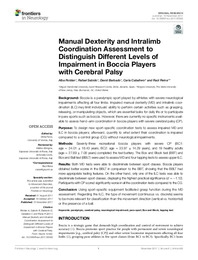Please use this identifier to cite or link to this item:
https://hdl.handle.net/11000/35244Full metadata record
| DC Field | Value | Language |
|---|---|---|
| dc.contributor.author | Roldán Romero, Alba | - |
| dc.contributor.other | Departamentos de la UMH::Ciencias del Deporte | es_ES |
| dc.date.accessioned | 2025-01-24T12:51:10Z | - |
| dc.date.available | 2025-01-24T12:51:10Z | - |
| dc.date.created | 2017-11-10 | - |
| dc.identifier.citation | Front. Neurol., 10 November 2017 Sec. Movement Disorders Volume 8 - 2017 | es_ES |
| dc.identifier.issn | 1664-2295 | - |
| dc.identifier.uri | https://hdl.handle.net/11000/35244 | - |
| dc.description.abstract | Background: Boccia is a paralympic sport played by athletes with severe neurological impairments affecting all four limbs. Impaired manual dexterity (MD) and intralimb coordination (ILC) may limit individuals’ ability to perform certain activities such as grasping, releasing, or manipulating objects, which are essential tasks for daily life or to participate in para sports such as boccia. However, there are currently no specific instruments available to assess hand–arm coordination in boccia players with severe cerebral palsy (CP). Purpose: To design new sport-specific coordination tests to assess impaired MD and ILC in boccia players; afterward, quantify to what extent their coordination is impaired compared to a control group (CG) without neurological impairments. Methods: Seventy-three recreational boccia players with severe CP (BC1: age = 34.01 ± 16.43 years; BC2: age = 33.97 ± 14.29 years), and 19 healthy adults (age = 27.89 ± 7.08 years) completed the test battery. The Box and Block test (BBT) and Box and Ball test (BBLT) were used to assess MD and four tapping tests to assess upper ILC. results: Both MD tests were able to discriminate between sport classes. Boccia players obtained better scores in the BBLT in comparison to the BBT, showing that the BBLT had more appropriate testing features. On the other hand, only one of the ILC tests was able to discriminate between sport classes, displaying the highest practical significance (d = −1.12). Participants with CP scored significantly worse in all the coordination tests compared to the CG. conclusion: Using sport-specific equipment facilitated grasp function during the MD assessment. Regarding the ILC, the type of movement (continuous vs. discrete) seems to be more relevant for classification than the movement direction (vertical vs. horizontal) or the presence of a ball. | es_ES |
| dc.format | application/pdf | es_ES |
| dc.format.extent | 9 | es_ES |
| dc.language.iso | eng | es_ES |
| dc.publisher | Frontiers Media | es_ES |
| dc.rights | info:eu-repo/semantics/openAccess | es_ES |
| dc.rights.uri | http://creativecommons.org/licenses/by-nc-nd/4.0/ | * |
| dc.subject | paralympic | es_ES |
| dc.subject | cerebral palsy | es_ES |
| dc.subject | neurological impairment | es_ES |
| dc.subject | para-sport | es_ES |
| dc.subject | Box and Block | es_ES |
| dc.subject | tapping test | es_ES |
| dc.subject.other | CDU::7 - Bellas artes::79 - Diversiones. Espectáculos. Cine. Teatro. Danza. Juegos.Deportes | es_ES |
| dc.title | Manual Dexterity and Intralimb Coordination Assessment to Distinguish Different Levels of Impairment in Boccia Players with Cerebral Palsy | es_ES |
| dc.type | info:eu-repo/semantics/article | es_ES |
| dc.relation.publisherversion | https://doi.org/10.3389/fneur.2017.00582 | es_ES |

View/Open:
fneur-08-00582.pdf
680,16 kB
Adobe PDF
Share:
.png)
